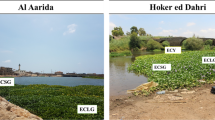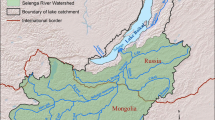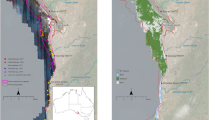Abstract
The ecological and economic impacts associated with invasive species are of critical concern to land managers. The ability to map the extent and severity of invasions would be a valuable contribution to management decisions relating to control and monitoring efforts. We investigated the use of hyperspectral imagery for mapping invasive aquatic plant species in the Sacramento-San Joaquin Delta in the Central Valley of California, at two spatial scales. Sixty-four flightlines of HyMap hyperspectral imagery were acquired over the study region covering an area of 2,139 km2 and field work was conducted to acquire GPS locations of target invasive species. We used spectral mixture analysis to classify two target invasive species; Brazilian waterweed (Egeria densa), a submerged invasive, and water hyacinth (Eichhornia crassipes), a floating emergent invasive. At the relatively fine spatial scale for five sites within the Delta (average size 51 ha) average classification accuracies were 93% for Brazilian waterweed and 73% for water hyacinth. However, at the coarser, Delta-wide scale (177,000 ha) these accuracy results were 29% for Brazilian waterweed and 65% for water hyacinth. The difference in accuracy is likely accounted for by the broad range in water turbidity and tide heights encountered across the Delta. These findings illustrate that hyperspectral imagery is a promising tool for discriminating target invasive species within the Sacramento-San Joaquin Delta waterways although more work is needed to develop classification tools that function under changing environmental conditions.
Similar content being viewed by others
References
Ackleson, S. G. and Klemas, V.: 1987, ‘Remote sensing of submerged aquatic vegetation in lower Chesapeake Bay: A comparison of Landsat MSS and TM Imagery’, Remote Sensing Environ. 22, 235–248.
Adams, J. B., Smith, M. O. and Johnson, P. E.: 1986, ‘Spectral mixture modeling: A new analysis of rock and soil types at the Viking Lander 1 site’. J. Geophysical. Res. 91, 8098–8112.
Adams, J. B., Smith, M. O. and Gillespie, A. R.: 1992, ‘Imaging Spectroscopy: Data analysis and interpretation based on spectral mixture analysis’, in: C. M. Pieters and P. A. J. Englert (eds), Remote Geochemical Analysis: Elemental and Mineralogical Composition. LPI and Cambridge University Press, Cambridge, pp 594.
Bossard, C. C., Randall, J. M. and Hoshovsky, M. C. (eds.): 2000, Invasive Plants of California's Wildlands. University of California Press, Berkeley, California.
Cocks, T., Jennsen, R., Stewart, A., Wilson, I. and Shields, T.: 1998, The HyMap airborne hyperspectral sensor: The system, calibration and performance’, in: Proceedings of the 1st EARSEL Workshop on Imaging Spectroscopy, October 1998, Zurich.
Dewey, S. A., Price, K. P. and Ramsey, D.: 1991, ‘Satellite remote sensing to predict potential distribution of dyers woad (Isatis tinctoia)’, Weed Technol. 5, 479–484.
DiPietro, D., Ustin, S. L., Underwood, E. C., Olmstead, K. and Scheer G. J.: 2002, ‘Mapping the invasive riparian weed Arundo donax (Giant Reed) using AVIRIS’, in: Proceedings of the Eleventh Annual JPL Airborne Visible Infrared Imaging Spectrometer (AVIRIS) Workshop, Jet Propulsion Laboratory, Pasadena, California.
DiTomaso, J. M. and Healy, E. A.: 2003, ‘Aquatic and Riparian Weeds of the West’, Agriculture and Natural Resources, University of California.
Drake, J. A., Mooney, H. A., di Castri, F., Groves, R. H., Kruger, F. J., Rejmánek, M. and Williamson, M. (eds.): 1989, Biological Invasions. A Global Perspective, John Wiley & Sons, Chichester, U.K.
Elmore, A. J., Mustard, J. F., Manning, S. J. and Lobell, D. B.: 2000, ‘Quantifying vegetation change in semiarid environments: Precision and accuracy of spectral mixture analysis and the normalized difference vegetation index’, Remote Sensing Environ. 73, 87–102.
Everitt, J. H., Anderson, G. L., Escobar, D. E., Davis, M. R., Spencer, N. R. and Andrascik, R. J.: 1995, ‘Use of remote sensing for detecting and mapping leafy spurge (Euphorbia esula)’, Weed Technol. 9, 599–609.
Everitt, J. H., Escobar, D. E., Alaniz, M. A., Davis, M. R. and Richerson, J. V.: 1996, ‘Using spatial information technologies to map Chinese tamarisk (Tamarix chinensis) infestations’, Weed Sci. 44, 194–201.
Gao, B. C., Heidebrecht, K. B. and Goetz, A. F. H.: 1992, ‘Atmospheric Removal Program (ATREM) user's guide, version 1.1’, Document Center for the Study of Earth From Space, University of Colorado, Colorado.
Gillespie, A. R., Smith, M. O., Adams, J. B., Willis, S. C., Fischer, A. F. III and Sabol, D. E.: 1990, ‘Interpretation of residual images: spectral mixture analysis of AVIRIS images, Owens Valley, California’, in: Proceedings of the Second Annual JPL Airborne Visible Infrared Imaging Spectrometer (AVIRIS) Workshop, Jet Propulsion Laboratory, Pasadena, California.
Hirano, A., Madden, M. and Welch, R.: 2003, ‘Hyperspectral image data for mapping wetland vegetation’, Wetlands 23(2), 436–448.
Jenson, J. R., Estes, J. E. and Tinney, L.: 1980, ‘Remote sensing techniques for kelp Surveys’, Photogrammetric Eng. Remote Sensing 46(6), 743–755.
Mooney, H. A. and Cleland, E. E.: 2001, ‘The evolutionary impact of invasive species’, Procedures of Nat. Acad. Sci. 98(10), 5446–5451.
Mulitsch, M. and Ustin, S. L.: 2003, ‘Mapping Invasive Plant Species in the Sacramento-San Joaquin Delta Region Using Hyperspectral Imagery’, Report, Center for Spatial Technologies and Remote Sensing at the University of California Davis, One Shield Avenue, Davis, California 95616. Submitted to the California Department of Boating and Waterways, 2000 Evergreen Street, Sacramento, California 95815.
Pimentel, D., Lach, L., Zunig, R. and Morrison, D.: 2002, ‘Environmental and economic costs associated with non-indigenous species in the United States’, Bioscience 50, 53–65.
Orth, R. J. and Moore, K. A.: 1983, ‘Submerged vascular plants: Techniques for analyzing their distribution and abundance’, Mar. Technol. Soc. J. 17(2), 38–52.
Penfound, W. and Earle, T.: 1948, ‘The biology of the water hyacinth’, Ecol. Monogr. 18, 447–472.
Pimm, S. L. and Gilpin, M. E.:1989, ‘Theoretical issues in conservation biology’, in: J. Roughgarden, R. May and S. A. Levin (eds), Perspectives in Ecological Theory, Princeton University Press, Princeton, New Jersey, pp. 287–205.
Research Systems Inc.: 2004, ‘Environment for Visualizing Images (ENVI) software version 4’, Boulder, Colorado.
Roberts, D. A., Smith, M. O., Adams, J. B., Sabol, D. E., Gillespie, A. R. and Willis, S. C.: 1990, ‘Isolating woody plant material and senescent vegetation from green vegetation’, in: Proceedings of the Second Annual JPL Airborne Visible Infrared Imaging Spectrometer (AVIRIS) Workshop, Jet Propulsion Laboratory, Pasadena, California.
Rueda, C. A. and Greenberg, J. A.: 2005, ‘STARSPAN tool for extracting image Data’, Comput. Geosci. (submitted)
Sanderson, E. W., Zhang, M., Ustin, S. L. and Rejmankova, E.: 1998, ‘Geostatistical scaling of canopy water content in a California salt marsh’, Landscape Ecol. 13, 79–92.
Scott, J. M. and Wilcove, D. S.: 1998, ‘Improving the future for endangered species’, Bioscience 48(8), 579–580.
Spanglet, H. J., Ustin, S. L. and Rejmankova, E.: 1998, ‘Spectral reflectance characteristics of California subalpine marsh plant communities’, Wetlands 18(3), 307–319.
Underwood, E. C., Ustin, S. L. and DiPietro, D.: 2003, ‘Mapping non-native plants using hyperspectral imagery’, Remote Sensing Environ. 86, 150–161.
Vis, C., Hudon, C. and Carignan, R.: 2003, ‘An evaluation of approaches used to determine the distribution and biomass of emergent and submerged aquatic macrophytes over large spatial scales’, Aquatic Bot. 77, 187–201.
Williams, D. J., Rybicki, N. B., Lombana, A. V., O'Brien, T. M. and Gomez, R. B.: 2003, ‘Preliminary investigation of submerged aquatic vegetation mapping using hyperspectral remote sensing’, Environ. Monit. Assess. 81, 383–392.
Williams, A. P. and Hunt, Jr., E. R.: 2002, ‘Estimation of leafy spurge cover from hyperspectral imagery using mixture tuned matched filtering’, Remote Sensing Environ. 82, 445–456.
Zhang, M., Ustin, S. L., Rejmankova, E. and Sanderson, E. W.: 1997, ‘Remote sensing of salt marshes: Potential for monitoring’, Ecol. Appl. 7(3), 1039–1053.
Author information
Authors and Affiliations
Corresponding author
Rights and permissions
About this article
Cite this article
Underwood, E.C., Mulitsch, M.J., Greenberg, J.A. et al. Mapping Invasive Aquatic Vegetation in the Sacramento-San Joaquin Delta using Hyperspectral Imagery. Environ Monit Assess 121, 47–64 (2006). https://doi.org/10.1007/s10661-005-9106-4
Received:
Accepted:
Published:
Issue Date:
DOI: https://doi.org/10.1007/s10661-005-9106-4




